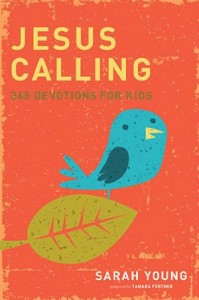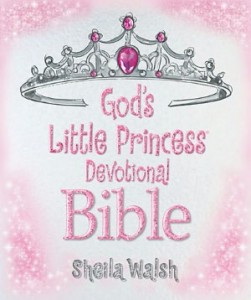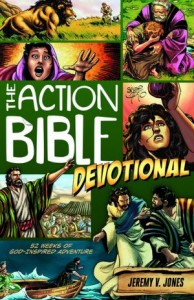“Thy word have I have treasured in my heart, that I may not sin . . .” (Ps. 119:11) More than anything, Christian parents want their children to treasure God’s word in their hearts, so it will be a guide and defense through the pitfalls of life. Starting them out right often includes a simplified Bible or Bible storybook, like the ones we’ve been discussing this week. But we’d like a little more: we’d like our children to start taking steps toward applying what they read in the word to their own lives. Sally Lloyd Jones shared with us on Tuesday how she was inspired to write Thoughts to Make Your Heart Sing when her happy, lively niece was browbeaten by bullies at school. God had something to say to that little girl, and Sally used her thoughts from scripture, adapted to a younger mindset, to communicate those great truths. Her new book (watch for Emily’s review tomorrow!) might be considered a devotional guide or collection of meditations, meant not to be devoured in a sitting but read and reread, chewed over and slowly digested. That’s what a good devotional book does, and Christians have benefited greatly from the thoughts of Charles Spurgeon and Oswald Chambers and other deep thinkers over the ages. Devotional guides for children are a fairly new development. Would they have the same benefit for kids as they do for adults? A few thoughts, before I get to some children’s devotionals that you’re likely to find on local Christian bookstore shelves.
1. Devotionals can become too routine. When I was a kid, my mother used a little booklet called “Power for Today” in family devotionals after dinner. The format never varied: a scripture, a brief exposition or illustration, a suggested song, a closing prayer. While the family tradition was nice, I don’t remember a single one of those inspiring thoughts. This is not to denigrate family devotionals at all, but we might consider more carefully how we structure them. Reading a brief scripture passage and asking questions might get the kids involved better than reading someone else’s thoughts about a scripture, followed by a prewritten prayer.
2. It’s my unprofessional opinion that children up to the age of, say, 11 or 12, are not that introspective. I’m sure there are plenty of exceptions: thoughtful kids who startle adults with their insights. But in the main younger children are geared more toward collecting information rather than pondering it. The pondering generally comes later, as adolescents are wondering who they are and where they fit in the world. What does this have to do with devotional guides? They are introspective by nature—the author invites the reader to think about a personal application of the Word. Great insights can be derived from a good devotional, but I’m not sure most kids younger than ten are ready to receive them. It might be a better use of their time to emphasize the what over the why and how–teach them what’s in the Bible, and demonstrate how it applies in your own life. They will learn application from you better than from a book.
3. We must always be careful not to substitute someone’s thoughts about what God says for what God actually says. The word of God is living and active and sharper than any two-edged sword—it convicts nations and pierces an individual to the innermost parts. What it says is common to everyone, but how it applies is personal. What I get out of a passage will be not be exactly the same as someone else’s interpretation, and the same scripture will affect me differently at the age of sixty than it did at the age of twenty. Of course we should encourage each other with our thoughts about scripture, and adults and teens can seek out devotional authors who speak to them. But younger kids might benefit more just from talking over what they read in the Bible with their parents or older Christians.
Having said all that, I’m excited about Sally Lloyd Jones’ new book, and I know the Lord will use it greatly to encourage many a child (and grownup). If I were shopping for a children’s devotional guide, I would want it to reflect two principles: the unity of scripture and the centrality of Christ. Thoughts to Make Your Heart Sing measures up to that standard, but how about some other popular guides?
Jesus Calling: 365 Devotions for Kids, by Sarah Young, adapted by Tama Fortner. Thomas Nelson, 2010, 392 pages. Age/interest level: 8-up.
Thomas Nelson, 2010, 392 pages. Age/interest level: 8-up.
Grace for the Moment: 365 Devotionals for Kids, by Max Lucado, adapted by Tama Fortner. Thomas Nelson, 2012, 400 pages. Age/interest level: 6-up.
Both these books were published first as guides for adults. Their popularity warranted “adapting” them for children—by the same person, as it happens. I can’t escape the suspicion that the publisher saw a good opportunity to piggy-back off an established title. There’s nothing inherently wrong with that; it’s just that the adaptation seems to be mostly a matter of simplified vocabulary, rather than reaching children where they live. Where they live (most of them, anyway) is concrete and physical, while both these books are more abstract and spiritual. Especially the former.
I wrote briefly about my Jesus Calling reservations on Tuesday, and here, again, is Tim Challies’ review. Sarah Young seems very sound, doctrinally, but the presentation is a bit troubling: as you may already know, she writes in first person—as the First Person. As though Jesus himself were speaking to the reader. In the Introduction she recounts how, after years of telling God her own thoughts in her prayer journal, she decided to stop talking and start listening, so to speak: “The devotions in this book are some of the messages I’ve received.” As the title indicates, there’s a reading for each day of the year. They’re very short—two or three paragraphs—each beginning with a printed scripture at the top of the page. At the bottom is a scripture reference that kids can look up on their own. The subjects apply to every Christian at any age–trust, faith, hope, etc.—treated in an expository way with not much in the way of illustration. For example:
Count on me. I will never let you down. And when others do let you down, I will be your safety net. I will not let you crash. Not only am I always there with you, I am holding your hand. And I promise, I won’t ever let go.
There’s very little in the way of concrete example, and sometimes “Jesus” sounds a wee bit syrupy. Peace is a big theme in Jesus Calling; perhaps the major theme. “Your greatest need is for the Peace you find in my Presence.” What about forgiveness of sins and reconciliation with God? “My Peace is the greatest of treasures.” Chapter and verse, please? “As you learn to live with me as the Center of your life, My Peace will fill you up.” Any room left for the Holy Spirit? I’ll admit, these devotions are probably better taken one at a time than all in a bunch at Mardel. Many Amazon reviewers say their kids love this book, and I wouldn’t argue with them. But at least one of those reviewers mentioned that her children were confused about the difference between the author speaking as Jesus, and Jesus actually speaking. That would be a red flag for me.
Grace for the Moment also seems too “adapted.” Each day of the year includes a scripture reference, a brief meditation, and a “Growing in Grace” suggestion to pray for something, talk to someone, do a kind deed, etc. Max Lucado includes more in the way of concrete illustration and example than Jesus Calling, which is more appropriate for this age. But he tends to focus on us–what we do, how we live–and less on Who God is and what He did. For instance, “Jesus’ goal was to save people from their sins” and no matter how ugly their deeds were, “He still saw enough beauty in people to die for their mistakes and for ours.” And when we get to heaven, “one of the greatest [blessings]will be you! You will be God’s magnum opus, his greatest work of art.” There is a sense in which this is true, and it’s definitely true that God delights in His people. But are kids going to get the wrong idea, that it’s all about them? The book doesn’t necessarily communicate that message overall, but there are probably better choices.
 God’s Little Princess Devotional Bible, by Sheila Walsh. Thomas Nelson, 2006, 352 pages. Ages 4-8
God’s Little Princess Devotional Bible, by Sheila Walsh. Thomas Nelson, 2006, 352 pages. Ages 4-8
God’s Mighty Warrior Devotional Bible, by Sheila Walsh. Thomas Nelson, 2007, 352 pages, ages 4-8.
I’ll admit to cringing a little as I pick up a pink “Bible” with a silver tiara on the cover—with rhinestones, no less! The “Princess” and “Warrior” stereotype may be just a tad relentless in these books, though I understand the need for gender roles and definitions. However, I was pleasantly surprised.
First of all, both books are written for kids, with their concerns and limited perspective in mind. And both books include liberal amounts of scripture, quoted from the International Children’s Version, a Bible translation I’ve used at home and in Sunday school for years. The references start with creation and Adam and Eve, but after that they skip around in no particular order, which is bad news for a sense of scriptural unity. Each section includes a passage (which may be a page or more), a brief application, and a “feature.” Princess features include “Beauty tips” (inner beauty), “My Hero” (qualities of God), “I Adore You” (praise), “Take a Bow” (short dramatizations), etc. The boys get “Adventure Quest” (games and activities), “Sword of the Spirit” (scripture memorization), “Shield of Faith” (making right choices) and so on. The language is clear and direct, the applications are appropriate to the age, and the activities seem fun and to the point (though it seems that boys get to do more of the fun stuff than girls!). Are they Christ-centered? I believe so. For instance:
Jesus is not only soft and gentle, he is also tough and strong. He is the fiercest fighter of evil. With wisdom and power he created the universe. He has declared war against sin and death. When he rose from the dead, he defeated the powers of hell.
Some activities you may want to skip, like letting little girls try on lipstick to remind them that “truly beautiful lips speak loving words from a kind heart.” On the other hand, little girls are going to try on your lipstick anyway, so why not try a spiritual application? It might just make an impression. Both books are a little over-designed for my taste, with an excess of borders and icons. Readings are not numbered; you can tell when you come to a contrasting color that you’ve reached the end of one and come to the beginning of another. The type is large and the wording simple enough that kids at the high end of the age range can read it themselves. These books may not be for everybody, but if Grandma buys one as a baby gift, don’t automatically write it off. They’re worth a second look.
The Action Bible Devotional: 52 Weeks of God-Inspired Adventure, by Jeremy V. Jones and Sergio Cariello. David C. Cook, 2012, 336 pages. Ages 8-up.
and Sergio Cariello. David C. Cook, 2012, 336 pages. Ages 8-up.
I like The Action Bible—scripture rendered in graphic novel (i.e., comic book) form. it’s a good choice for fidgety boys and unenthusiastic readers, faithful to the Word and dramatically presented. (See our interview with the artist, Sergio Cariello!) The Devotional selects a story for every week of the year and encourages application through four steps: “X-Ray Vision” (thoughts to connect the story to your life), “Your Mission” (three application ideas and activities), “Your Debrief” (three questions to ask yourself), and “Mission Accomplished” (space to write your own thoughts). Since the stories are chronological and developmental, they do show the unity of scripture. But the centrality of Christ gets lost in all the personal character-building. Some of the takeaways are direct and effective, like tearing down your own idols (after the golden calf story). However, too many of them read like last week’s after-school special. The story of Deborah becomes a lesson on gender identities. Jesus’ baptism, and God’s endorsement of “my beloved Son, in whom I am well pleased” is all about . . . encouragement. (As a comic-book character might say, “What the–?!”) The raising of Lazarus, before which “Jesus wept” is not a demonstration of the mighty power of God, but an examination of empathy. As a devotional guide, I’d leave this one alone. Next year, Cook plans to publish The Action Bible Handbook: a Dictionary of People, Places, and Things. That sounds like a better use of the franchise.
Our readers have had some good suggestions, and in examining some of those I found a real treasure. But this post is long enough! I’ll finish it next week.
Support our writers and help keep Redeemed Reader ad-free by joining the Redeemed Reader Fellowship.
Stay Up to Date!
Get the information you need to make wise choices about books for your children and teens.
Our weekly newsletter includes our latest reviews, related links from around the web, a featured book list, book trivia, and more. We never sell your information. You may unsubscribe at any time.
We'd love to hear from you!
Our comments are now limited to our members (both Silver and Golden Key). Members, you just need to log in with your normal log-in credentials!
Not a member yet? You can join the Silver Key ($2.99/month) for a free 2-week trial. Cancel at any time. Find out more about membership here.
2 Comments
Leave a Comment
You must be logged in to post a comment.


Thanks so much, Janie! I was really curious and a little concerned about what might be in the Action Bible devotional. I suspect it will be really popular, since The Action Bible was the #1 selling Christian kids’ book for a while. Also, I appreciate your scrutiny of the Jesus Calling phenomenon. I suspect a lot of kids may benefit from the truth it does contain. But like Heaven is For Real, it introduces a wrong idea of revelation and our interpretation of it.
In line with your thinking, my understanding is that we should strive to pray and learn from God’s word not as a platform to launch from, but as a text with an historical, particular message to savor and apply in our own contexts. I think that’s what’s different about Sally Lloyd Jones’s writing usually: she helps kids apply the historical, basic meaning of texts to our everyday lives, not use the text as a jumping off point for whatever “inspiration” hits us. A subtle difference, but significant nonetheless.
I’m so glad you reviewed The Action Bible Devotional. I was very curious to see what it was like, but the Amazon listing doesn’t have the “see inside the book” feature enabled, and all the copies at my local bookstore were shrink-wrapped. It was helpful to read your review.